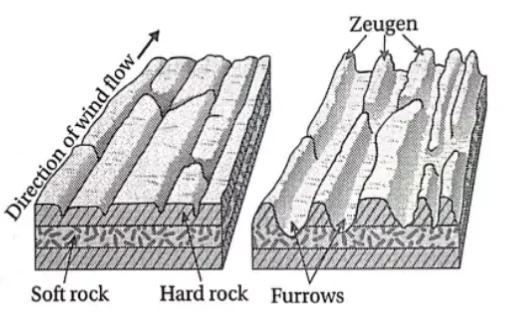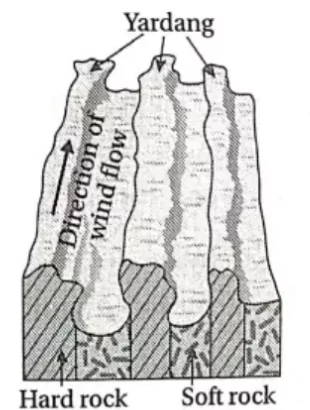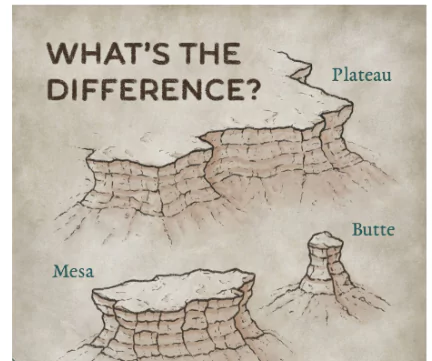Deserts, with their harsh conditions and sparse vegetation, are landscapes shaped by erosion over millennia. From the gradual carving of mesas and buttes to the formation of ephemeral playas, desert erosion creates a tapestry of unique landforms. Wind, water, and time work together to sculpt these features, revealing the timeless beauty of desert landscapes.
Overview of Erosional Landforms in Deserts
Pediments and Pediplains: Pediments are gently inclined rocky surfaces found near the bases of mountains, sometimes covered with a thin layer of debris.

-
- They are formed through a combination of lateral erosion by streams and sheet flooding.
- This erosion process leads to the extension of pediments at the expense of mountain fronts.
- Over time, the mountains reduce in size, leaving behind inselbergs as remnants.
- Ultimately, the high-relief desert areas transform into low, featureless plains known as pediplains.
- Zeugen: These are tabular masses that have a layer of soft rocks lying beneath a surface layer of more resistant rocks.
- Wind abrasion eats into the underlying softer layer so that deep furrows are developed.
- The hard rocks then stand above the furrows as ridges or zeugen.
- Yardangs: Instead of lying in horizontal strata upon one another, the hard and soft rocks of yardangs are vertical bands and are aligned in the direction of the prevailing winds.
 Playas: Playas are shallow lakes formed at the centre of basins surrounded by mountains and hills;
Playas: Playas are shallow lakes formed at the centre of basins surrounded by mountains and hills;
- Have short-lived water retention due to high evaporation rates and often contain salt deposits.
- Deflation Hollows and Caves: Deflation Hollows are shallow depressions created by wind-blown sand and persistent wind currents.
- Wind-driven sand abrades rock surfaces, forming blowouts that may develop into caves.
- Mesas and Buttes: It is a flat, table-like land mass with a very resistant horizontal top layer and very steep sides.
- Continued denudation through the ages may reduce mesas in the area so that they become isolated flat-topped hills called buttes.
- Inselberg: It is characterised by its steep slopes and rather rounded tops.
- They are often composed of granite or gneiss and are probably the relics of an original plateau that has been almost entirely eroded away.
 Deflation Hollow: Winds lower the ground by blowing away the unconsolidated materials, and small depressions may form.
Deflation Hollow: Winds lower the ground by blowing away the unconsolidated materials, and small depressions may form. -
- Water then seeps out, forming oases or swamps, in the deflation hollows or depressions.
- Mushroom, Table, and Pedestal Rocks: Resistant rock remnants polished by wind erosion take on various shapes, such as,
- Mushroom Rocks: which have a slender stalk and a rounded, pear-shaped cap.
- Table Rocks: have broad, flat tops.
- Pedestal Rocks: stand tall like pillars.
Enroll now for UPSC Online Course
Conclusion
- Desert erosion is a dynamic process that leaves behind a variety of distinctive landforms. From the iconic mesas and buttes to the intricate patterns of yardangs and zeugen, each feature tells a story of nature’s enduring forces.
- As winds and water shape the land, deserts change over time, showing how erosion shapes their landscapes.
![]() April 29, 2024
April 29, 2024
![]() 3583
3583
![]() 0
0

 Playas: Playas are shallow lakes formed at the centre of basins surrounded by mountains and hills;
Playas: Playas are shallow lakes formed at the centre of basins surrounded by mountains and hills;
 Deflation Hollow: Winds lower the ground by blowing away the unconsolidated materials, and small depressions may form.
Deflation Hollow: Winds lower the ground by blowing away the unconsolidated materials, and small depressions may form.